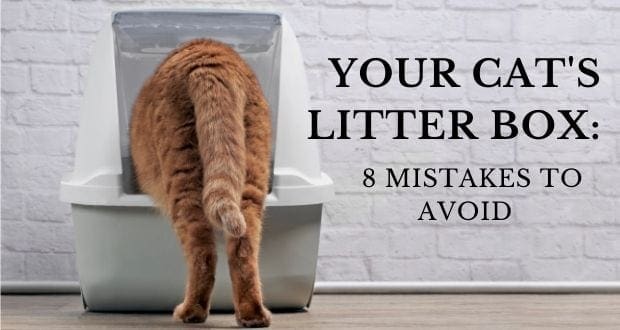
The cat’s relationship with the litter box is more complex than many cat parents realize. We typically assume the litter box to be a place where a cat simply eliminates. It’s the place we want kitty’s pee and poo to be exclusively deposited and as long as kitty follows the plan, everyone is happy. For the cat though, the relationship to the litter box is more complicated than just an elimination spot. It’s important to look at your cat’s litter box set-up from his perspective to make sure it meets his needs and not just our convenience. The needs of a young kitten may be different from the needs of an adult. The needs of an overweight or senior cat may be different from those of an active young cat. If you live with more than one cat, the litter box needs will be different than when there was just one kitty. You have to make sure the set-up works for YOUR cat.
When it comes to the litter box, there are certainly more than just 8 mistakes that cat parents can make but here are the ones I tend to see most often during my consultations.
1. The Wrong Sized Litter Box
A mistake I commonly see is that a cat parent will purchase a particular litter box in order to fit it into a tiny or cramped spot so it can remain out of sight. The size of the litter box should be determined based on the size of the cat. Here is my general recommendation: the box should be 1 ½ times the length of your cat from nose to base of tail.
2. A Litter Box That isn’t Cleaned Enough
I’ve said it many times over the years – a dirty litter box is like an unflushed toilet – but yet many human family members don’t seem to understand how a dirty box is just as unappealing to a cat as a dirty toilet would be for us. The litter box should be scooped at least twice a day. If using scoopable litter, the entire box should be emptied, scrubbed and refilled with fresh litter at least once a month. If using non-clumping litter then the box should be scrubbed and refilled at least weekly.
3. Choosing the Wrong Location for the Litter Box
The first rule is to never place the litter box near the feeding station because no one likes to eat next to the toilet. For cats, the separation of the feeding station and elimination location is also based in survival. Cats eliminate away from where they live to avoid attracting predators.
When it comes to location it’s also important to look at what’s convenient and easy to access for the cat. A litter box in the basement may be unappealing because of the dampness or because of the discomfort of going up and down stairs if a cat is older or less mobile. A cat shouldn’t have to travel too far to find a place to pee or poop. There should be litter box availability on each floor of your home. The box should be a location that’s safe and will allow the cat to eliminate without being disturbed or startled.
4. Too Few Litter Boxes in a Multicat Household
If you have more than one cat you need more than one litter box. The general rule of thumb is to have more litter boxes than you have cats. The litter boxes should be scattered throughout the home so one cat doesn’t have to pass through another cat’s preferred area. One of the ways to keep peace in a multicat home is to not force cats to compete for resources. If you have five cats it may not seem like much fun to have to scoop six litter boxes but it’s better than having some or all of the cats stressed out and maybe ending up with a litter box avoidance problem. Cleaning a litter box is easier than cleaning soiled carpet.
5. Unappealing Litter in the Box
A cat may have a preference in terms of texture or even scent (or lack of). In general, cats prefer a soft, sandy texture and that’s where most of the scoopable litters are ideal. Stay away from scented litter because a cat’s nose is very sensitive and he may not want to get a sensory assault of roses or perfume when he steps into the litter box.
Cats are creatures of habit so if you decide to change types or brands of litter, do it gradually over the course of about five days by mixing the new kind into the current litter.
If you’re completely unsure what type of litter your cat likes, set out a litter box buffet with a different brand in each box. Your cat will let you know which one is the winner.
6. Not Enough Litter in the Box
Although I’ve seen cat parents dump far too much litter in the box, what I see most often is a scant amount that barely covers the bottom. There needs to be enough litter in the box to absorb liquid and therefore absorb the odor. If the urine hits the bottom of the box and just sits there you end up with a stinky box and in addition to you not liking that, your cat will be very unhappy as well. About a three-inch layer of litter is a good starting point and then you can adjust up or down from there based on how things go with your individual cat.
7. A covered and Cramped Litter Box
Humans certainly know that cats pee and poop but many just don’t want to see it on display in the litter box so they buy covered boxes. Many cat parents also don’t like the floor or carpet around the box decorated with litter that has been kicked out over the sides so the get a covered box to keep everything contained. And finally, covered boxes hold the appeal of providing privacy. With all that said, a covered box has more negatives than positives. Most covered boxes are too small and most cats feel cramped in there. As a result, you may find half of your cat sticking out of the box entrance during elimination. If you’re lucky, the front end is the part sticking out and if you’re not so lucky, it’s the business end.
Covered boxes also don’t allow for efficient drying of the litter and although you may not be able to smell anything, your cat certainly will whenever he steps into the box. The covered box may also not get scooped as often as needed because it’s more inconvenient to remove the lid in order to clean it.
While the covered box does provide privacy, it also lacks escape potential. I’ve written about this many times because it’s important, especially in a multiple cat household, for the cat in the box to not feel trapped or to ever be vulnerable to an ambush. The quickest way to a litter box problem is for a cat to not feel safe in there.
8. Punishment and Assumptions
It’s very sad to see a cat parent punish a cat for a litter box avoidance problem because it will only lead to a bigger problem and increase the stress already felt by the kitty. Cats don’t eliminate outside of the litter box out of spite or as a misbehavior. If a cat doesn’t use the box it’s because he can’t for some reason. Don’t immediately assume a missed litter box elimination is behavioral and don’t reprimand the cat. Very often, the reason a cat goes outside of the box is due to an underlying medical condition. Make sure your cat is checked by the veterinarian before assuming it’s a behavior problem. Once the cat gets a clean bill of health you can work on figuring out what’s keeping him away from the box. It may be the box set-up, lack of maintenance, something going on in the household, multicat issues or any of the other things previously mentioned in this article. Instead of punishing the cat which is counter-productive and possibly damaging to your relationship, look at the environment from his perspective and you may surprise yourself in what you’ll discover.
Need More Information?
For more specific information on litter box training and litter box problems, refer to the bet-selling books by Pam Johnson-Bennett. Pam’s books are available in bookstores and online. We’ve included links to Amazon on our website.
If you have a question about your cat’s behavior or health, contact your veterinarian. This article is not intended as a medical diagnosis nor is it a replacement for your cat’s regular veterinary care. This article is for general information purposes only.



